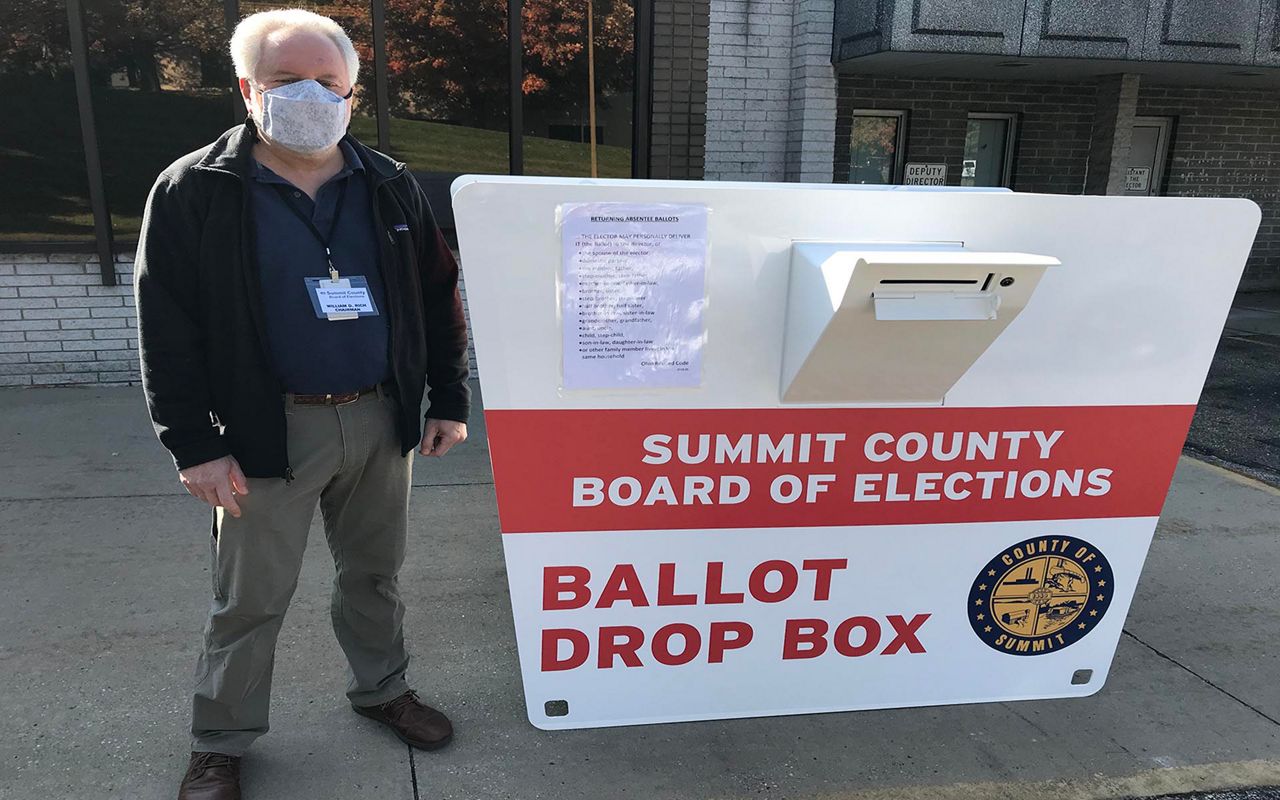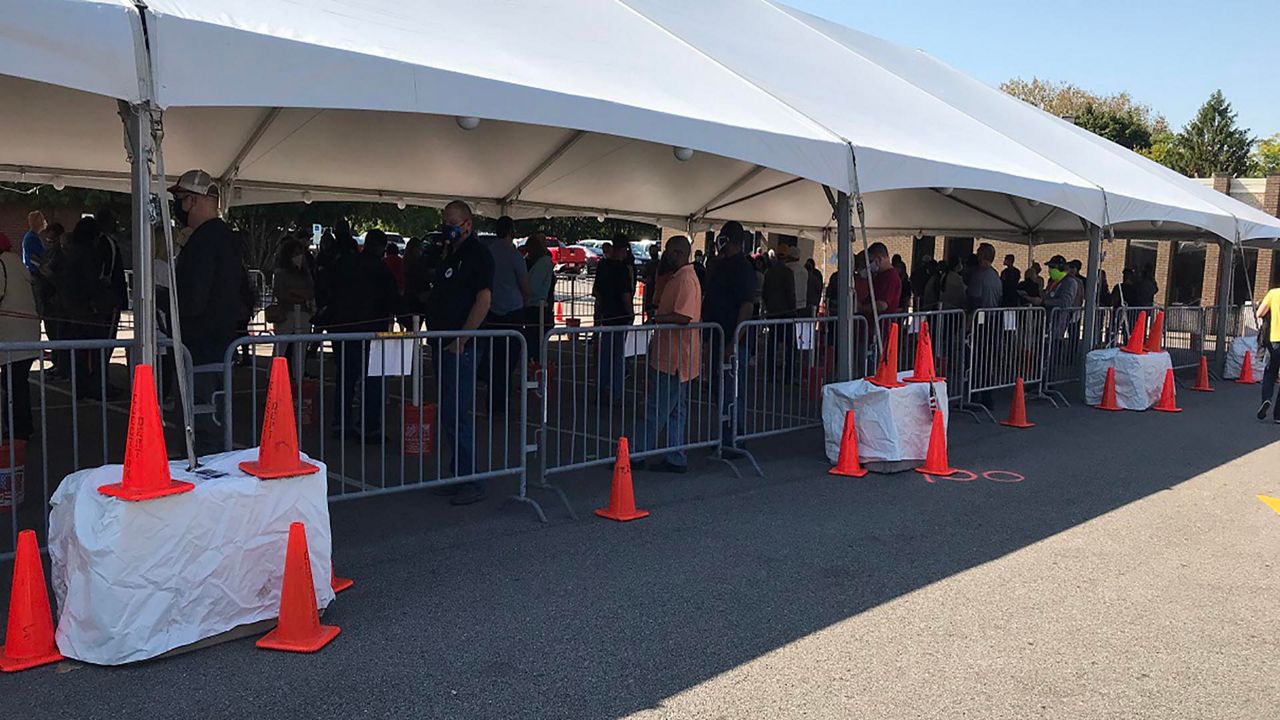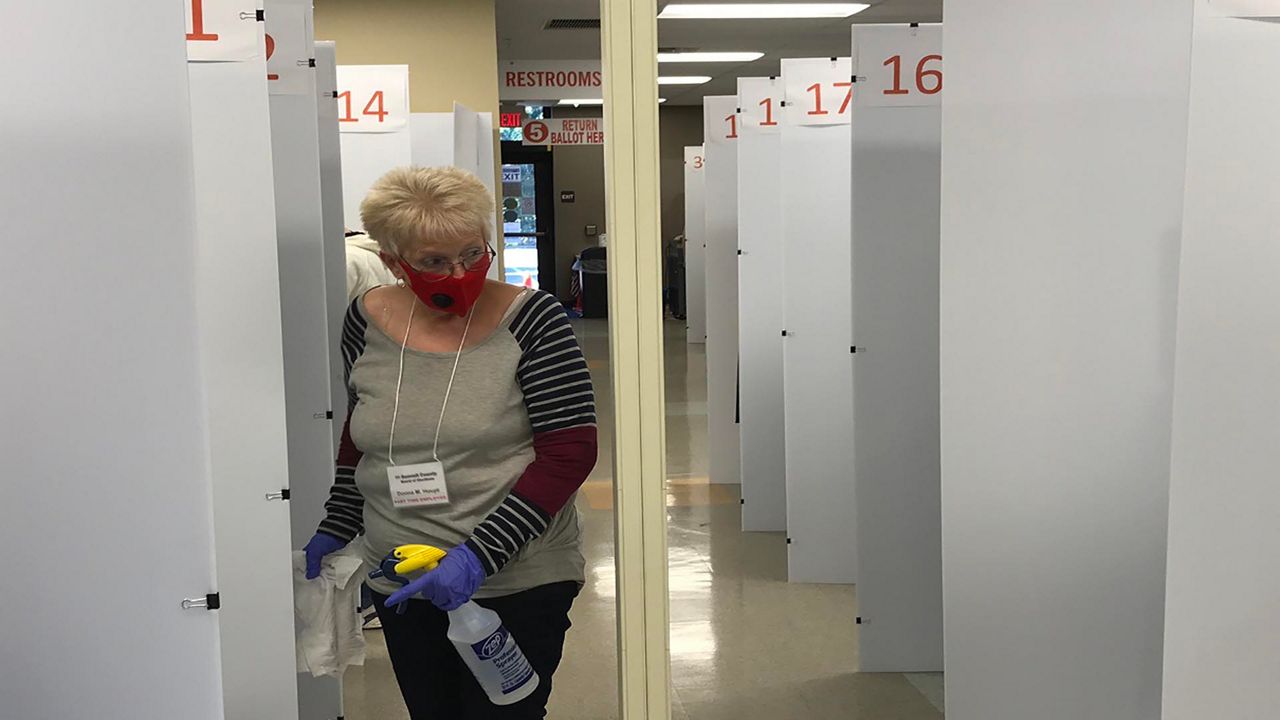SUMMIT COUNTY, Ohio - The Summit County Board of Elections (BOE) pulled out the stops for the upcoming General Election, from installing a large tent to ensure voters have cover from Ohio’s moody weather, to installing a second, oversized drop-off ballot box for those voting absentee. Tall, plastic dividers are being installed at voting locations to help keep voters safe as well.
What the BOE could not control was a mishap at an area printer, which set back distribution of 95,000 absentee ballots by a full week.
When a second round of nearly 15,000 absentee ballots was also delayed beyond what Cleveland-based MidWest Direct promised, the BOE brought all remaining absentee ballot processing in house, said Board of Elections Board Chair Bill Rich.
Absentee ballots from the first batch started hitting mailboxes last week—about four days later than planned, he said.
And the mishap affected only timing of ballot delivery—not addresses or recipients, he said.

“We're obviously getting lots of phone calls. Lots of emails,” said BOE Director Lance Reed. “People are already worrying about the postal service because people have been making comments about that. I'd like to tell people to be patient, but I can certainly understand why they are not, as well.”
In past elections, the BOE has handled fulfillment internally, which means printing the ballots and addressing, stuffing and mailing the envelopes containing the ballots. But this election, the agency faced two constraints, Rich said.
“No. 1: We knew we were going to have a lot more absentee ballots to process,” Rich said. “But No.2: We have to maintain distance between people. And you can only put so many people in the building and maintain distance. So, that kind of pushed us over the edge toward contracting it out.”
Midwest Direct was contracted to handle printing, stuffing and mailing the ballots for 19 Ohio counties. But mechanical problems coupled with sheer volume set the printer back for the first batch, he said.
It also took Summit County BOE repeated requests for information to elicit a response from the beleaguered printer, Rich said.
When Midwest promised the second batch of ballots for Summit County would drop within a 48-hour window, it instead turned into a few days, with ballots expected to arrive starting Tuesday next week, he said.
That setback caused the BOE to take action, he said.
“I don't know that we get them out any faster, but what we're going to do is basically keep up on a day to day basis after that,” Rich said. “So, every day, we should have—we hope—a one-day turn around.”
The state-mandated cut off to request absentee ballots is noon on Saturday, Oct. 31.
To ensure voters have time to fill out their ballots and either return it in person or ensure it’s postmarked by Nov. 2, voters should not delay in submitting a request for an absentee ballot, Rich said.
“It doesn't need to be today, but the sooner the better,” he said. “And certainly don't wait 'till close to the deadline.”
The BOE is getting mixed feedback on the lag time in voters receiving their absentee ballots, Reed said.
“It's probably a 60/40 thing where most people say, ‘OK, thanks. I'll just wait a few extra days and get my ballot,’ and the other 40 percent are saying, ‘’Well, I want it now. And how couldn't you guys get this right? You know, you have one job to do, which is get the ballots to voters.'”
Reed understands the frustration but said a week’s delay won’t hinder election results.
“If there was a one-week delay on Oct. 24, then you've got a major issue,” he said. “But if we were going to run into it, I'd much rather happen on the front end, because by the time they get their ballots this week, it'll still give them about two and a half to three weeks to get their ballots back to us, whether that's through the postal stream or hand-delivering them back to us. Either way is fine.”
People seem anxious to vote early, with the tent outside the early voting building remaining largely steady.

“You have a significant number of people who, for whatever reason, maybe don't want to go to the polling locations on Election Day—whether it's COVID or whether it's they don't trust the mail,” Reed said. “So, they want to come vote absentee in person.”
Outside, the oversized drop box on the north side of the building complements a smaller drop box stationed in front of the BOE on Grant Street just outside downtown Akron. That too is unusual, because prior to this election, the BOE was not required to have a ballot drop box outside, Rich said.
Knowing voter numbers would be high this election, the BOE installed the second, bigger box, wrapped up in the Summit County logo, which people can drive up to, he said. Instructions on the box detail who can drop ballots off for whom.
A team of one Republican and one Democrat—each with a different key—open and empty the boxes regularly.
“There's always a Democrat and Republican on any given task. Each one is there to check the other,” Rich said. “We're probably among the most extreme in that way. But all parts of elections do have equal numbers of Democrats and Republicans, at least on critical tasks.”
Voters who requested mail-in ballots can vote in person if they change their minds, Rich said. There’s no danger of being counted twice, because the BOE’s electronic backend contains detailed databases that flag anyone who was sent an absentee ballot, Rich said.
“We will know that we sent you a ballot,” he said. “Even if you don't bring one back with you. Even if you don't tell us. We will know we sent you a ballot.”
The number of absentee ballot requests is twice what they were in General Elections in 2012 and 2016, Reed said, when each election averaged about 60,000 voters requesting mail-in ballots.
“Right now, we're at 115,000,” he said. “So, the workload just changes tremendously in that way.”
For people voting in person, the BOE has installed Plexiglas in worker areas and for those waiting their turn to enter new, very tall, protective voting booths. The plastic booths can fit twice the number of people inside the building and keeping voting moving while helping keep people safe from COVID-19, Rich said.

Each time a booth is cleared, staffers go through with disinfectant to prepare for the next voter.
The BOE normally brings in temporary workers to help out in a General Election. Right now, about 100 workers are part time, in addition to the 100 full-time staff, Rich said. Now that the agency is handling absentee ballot requests in-house, the number of part-time workers will rise even more.
How long they will work is unknown.
“We will have an audit for sure,” Reed said. “But it also depends on whether we have a recount, because if we have a recount, we have to do that before we perform the audit. So, it just depends on how much workload there is heading into the end of November and into December.”
As for counting all those votes, the BOE preparing by processing ballots as they come in using high-speed scanners, Rich said.
“We have it set so that it doesn't give us tallies. It's recording the votes, but it's not telling us the numbers,” he said. “And then at 7:30 or after 7:30 on Election Day, we basically flip the switch and it gives us the tallies. So, it's recording all that.”
By “flipping the switch,” Rich is referring to the scanners’ memory cards, which will be plugged into card readers to tally the votes. Those votes are what the public sees go up first on election night on the BOE website.
Apart from the printer issue, the process is going smoothly so far, Reed said, with staffers in the early voting center hearing positive feedback.
“The comments over there have been overwhelmingly positive, which is kind of reassuring, considering we put a lot of thought and effort into ensuring we could keep voters as safe as possible over there knowing that we are going to have a significant number of people come and vote early, in person,” he said. “It's been pleasant news to my ears. I'll say that.”



